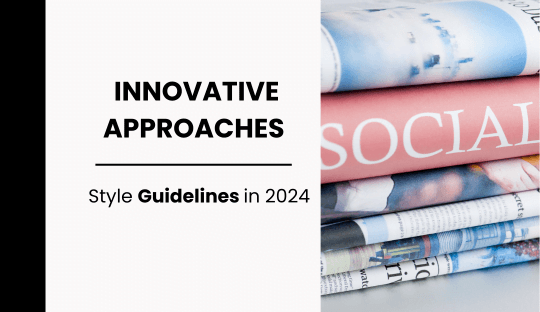
Innovative Approaches to Brand Style Guidelines in 2024
Introduction
As the digital landscape evolves, so do the methods for establishing and maintaining a brand’s visual and verbal identity. For Flykez CO, a creative brand company in the Czech Republic, adopting innovative approaches to brand style guidelines can significantly enhance brand recognition and consistency. This article explores the latest trends and strategies for developing effective brand style guidelines in 2024.
Embracing Digital-First Guidelines
In 2024, brand style guidelines are increasingly designed with a digital-first approach. This means prioritizing guidelines that ensure brand consistency across digital platforms such as websites, social media, and mobile applications. Digital-first guidelines focus on how the brand’s visual and verbal elements are displayed and interacted with on various screens and devices.
Interactive Digital Manuals
Interactive digital manuals are replacing static PDF documents. These online guides are easily accessible and updatable, ensuring that all stakeholders always have the latest information. They can include clickable elements, embedded videos, and interactive examples that demonstrate proper brand usage.
Incorporating Multimedia Elements
Modern brand style guidelines are no longer limited to text and images. They now include multimedia elements to provide a richer understanding of brand identity. This includes video tutorials, audio clips, and motion graphics that illustrate how to use the brand’s assets effectively.
Video Tutorials
Video tutorials can be particularly effective in demonstrating complex brand elements such as animation guidelines or intricate logo applications. These videos provide clear, step-by-step instructions that are easy to follow and replicate.
Motion Graphics
Motion graphics add an extra layer of depth to brand guidelines. They can show how logos and other brand elements should animate in digital environments, ensuring a consistent brand experience across dynamic media.
Leveraging AI and Automation
Artificial Intelligence (AI) and automation are transforming how brand style guidelines are created and maintained. AI tools can help analyze and suggest improvements to brand assets, ensuring they remain current and effective. Also Read About Why Every Business Needs a Brand Style Guide
AI-Powered Design Tools
AI-powered design tools can assist in maintaining brand consistency by automatically adjusting assets to fit different formats and platforms. These tools can ensure that logos, colors, and typography adhere to the established guidelines, reducing the risk of human error.
Automated Updates
Automated updates ensure that all brand materials remain consistent with the latest guidelines. When a change is made to the brand style guide, automated systems can update templates and assets across all platforms, ensuring immediate and uniform implementation.
Emphasizing Accessibility and Inclusivity
In 2024, there is a growing emphasis on making brand style guidelines accessible and inclusive. This means ensuring that all brand elements are usable by people of all abilities and that the brand communicates inclusively to diverse audiences.
Accessible Design Standards
Accessible design standards include guidelines for color contrast, font size, and screen reader compatibility. These standards ensure that the brand’s digital assets are accessible to individuals with disabilities, enhancing the brand’s reach and reputation.
Inclusive Language Guidelines
Inclusive language guidelines ensure that all written content reflects the brand’s commitment to diversity and inclusivity. This involves using gender-neutral language, avoiding stereotypes, and being mindful of cultural sensitivities.
Sustainability and Eco-Friendly Practices
Sustainability is becoming a core value for many brands. Incorporating eco-friendly practices into brand style guidelines not only reflects the brand’s commitment to the environment but also appeals to a growing segment of environmentally conscious consumers.
Sustainable Printing Guidelines
For printed materials, sustainable printing guidelines specify the use of recycled paper, eco-friendly inks, and minimal packaging. These guidelines help reduce the brand’s environmental footprint and demonstrate a commitment to sustainability.
Digital-First Strategies
Prioritizing digital over print can significantly reduce the environmental impact of brand communications. Digital-first strategies encourage the use of digital brochures, e-cards, and online marketing campaigns instead of their printed counterparts.
Continuous Evolution and Flexibility
Brand style guidelines in 2024 are designed to be living documents that evolve with the brand. This flexibility allows the brand to adapt to changing market conditions, consumer preferences, and technological advancements.
Regular Reviews and Updates
Regular reviews and updates ensure that the brand style guidelines remain relevant and effective. Scheduled audits can identify areas for improvement and ensure that all brand elements are aligned with the latest trends and standards.
Feedback Loops
Establishing feedback loops allows employees, designers, and stakeholders to contribute to the ongoing development of the brand style guidelines. This collaborative approach ensures that the guidelines are practical, user-friendly, and reflective of the brand’s needs.
Conclusion
Innovative approaches to brand style guidelines are essential for maintaining a cohesive and impactful brand identity in 2024. For Flykez CO, embracing digital-first strategies, incorporating multimedia elements, leveraging AI, emphasizing accessibility, and committing to sustainability can enhance brand consistency and identity. By continuously evolving and updating the brand style guidelines, Flykez CO can ensure a strong and adaptable brand presence in the competitive market of the Czech Republic and beyond.
For more information on how Flykez CO can help with your branding needs, visit www.flykez.com.
